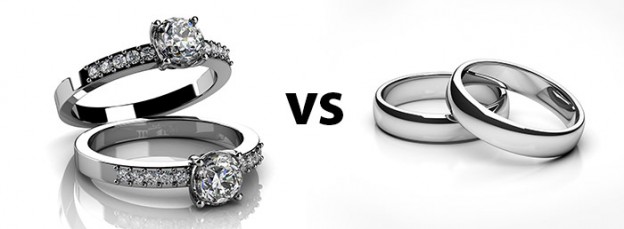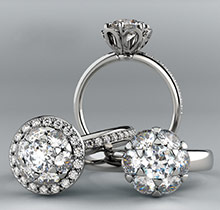The popularity for white gold and platinum has skyrocketed in recent years, especially for engagement rings and wedding bands. While the two metals look alike, they are actually quite different. Each metal has unique properties and benefits.
Color
While both metals look white, especially when they are new, white gold is not actually white. White gold is actually yellow gold with alloys added to give it a white appearance. Even with these added alloys, it is still not completely white. It is usually plated with rhodium to make it appear bright white. The rhodium wears off over time, requiring the piece to be replated to maintain its white appearance. This is especially true for rings and bracelets, which receive the most wear.
Platinum is a completely white metal and never requires plating. The shiny finish will dull over time but it can be professionally shined to restore its luster.
Durability: Platinum is significantly stronger and more durable than white gold. It is also 60 percent heavier. Platinum will scratch but because it is soft, the metal is simply displaced and no metal is actually lost.
Because white gold is hard, a little bit comes off each time it is bumped or brushed against something or it is polished. This causes it to become thinner and more likely to break over time. White gold jewelry may require maintenance over the years, including plating, reshanking, and retipping prongs.
Allergies: If you have sensitive skin or are allergic to certain metals, platinum may be the safer choice. Some people have an allergy to the alloys used in white gold jewelry. A nickel allergy is most common. Platinum is hypoallergenic and poses no issue for people with sensitive skin.
Cost: Platinum is a rare metal and one of the most expensive metals. It can be several times the cost of white gold. Platinum is more pure than white gold. Platinum used in jewelry is 90 to 95 percent pure versus 58.5 percent pure for 14k gold. It is also denser than gold and needs more metal to create the same sized piece of jewelry. Platinum is more challenging to work with and requires greater skill. All of these factors drive up the cost of platinum jewelry.
Best uses:
Each metal is well suited for certain uses.
Platinum is best for:
- Ring settings with small stones with prong or pave settings
- Jewelry with intricate designs or a lot of detailing
- Jewelry that will receive heavy use
White gold is best for:
- Rings with fewer gems
- Jewelry with a polished surface
- Gems that are securely set, such as channel settings and bezel settings
- Jewelry that doesn’t have much contact with surfaces, such as pendants and earrings
Ultimately the choice is a personal one, but having the facts can make it an easier decision to make.


